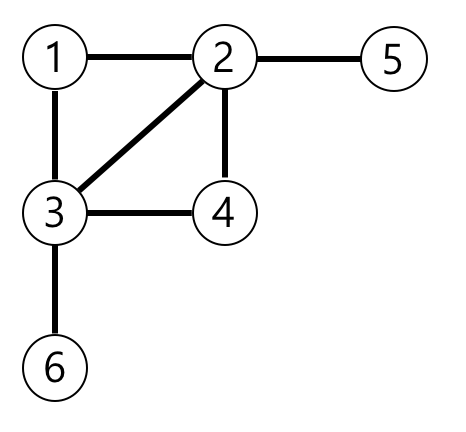링크
문제 설명
n개의 노드가 있는 그래프가 있습니다. 각 노드는 1부터 n까지 번호가 적혀있습니다. 1번 노드에서 가장 멀리 떨어진 노드의 갯수를 구하려고 합니다. 가장 멀리 떨어진 노드란 최단경로로 이동했을 때 간선의 개수가 가장 많은 노드들을 의미합니다.
노드의 개수 n, 간선에 대한 정보가 담긴 2차원 배열 vertex가 매개변수로 주어질 때, 1번 노드로부터 가장 멀리 떨어진 노드가 몇 개인지를 return 하도록 solution 함수를 작성해주세요.
제한사항
- 노드의 개수 n은 2 이상 20,000 이하입니다.
- 간선은 양방향이며 총 1개 이상 50,000개 이하의 간선이 있습니다.
- vertex 배열 각 행 [a, b]는 a번 노드와 b번 노드 사이에 간선이 있다는 의미입니다.
입출력 예
입출력 예 설명
예제의 그래프를 표현하면 아래 그림과 같고, 1번 노드에서 가장 멀리 떨어진 노드는 4,5,6번 노드입니다.
풀이
- BFS (너비 우선 탐색)을 통해 1번 노드로부터 모두 얼마나 걸리는지 distance에 저장한다.
- BFS 하는 과정에서 가장 먼 노드가 얼마나 떨어져있는지 알기위해 max값에 그 거리를 저장해두자
이 문제는 BFS로 정말 쉽게 풀었다.
그러나 Queue 구현체에서 습관대로 PriorityQueue로 받아서 오류를 마주했지만 바로 LinkedList로 바꿔서 해결하였다.
그 외에는 딱히 어려운 점은 없었다.
코드
import java.util.*; class Solution { static boolean[] visited; static boolean[][] map; static int[] distance; public int bfs(int start) { Queue<Integer> q = new LinkedList(); int max = -1; int res = 0; q.add(start); visited[start] = true; while(!q.isEmpty()) { int now = q.poll(); for(int i = 1; i < map.length; i++) { if(!visited[i] && map[now][i]) { q.add(i); visited[i] = true; distance[i] = distance[now] + 1; if(max < distance[i]) max = distance[i]; } } } for(int i = 0; i < distance.length; i++) if(distance[i] == max) res++; return res; } public int solution(int n, int[][] edge) { int answer = 0; visited = new boolean[n + 1]; distance = new int[n + 1]; map = new boolean[n + 1][n + 1]; for(int i = 0; i < edge.length; i++) { map[edge[i][0]][edge[i][1]] = true; map[edge[i][1]][edge[i][0]] = true; } answer = bfs(1); return answer; } }



.jpg)